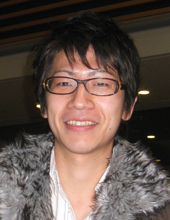Top>Hakumon CHUO [2012 Early Spring Issue]>[The spring of a lively bunch] Immersed in research as the first batch of Department of Biological Sciences students Evaluated on effort, finding work at a synthetic water treatment company
 Index
Index
The spring of a lively bunch
Immersed in research as the first batch of Department of Biological Sciences students
Evaluated on effort, finding work at a synthetic water treatment company
Ryunosuke Futamura
Faculty of Science and Engineering (Kanagawa Prefectural Kamakura High School graduate)

"Tackle everything you want to do with all your strength." - This is what Futamura asserts in response to being asked what is important during four years at university. It is a fact that he accomplished what he wanted to do in his four years centered on research at the laboratory.
Futamura entered Chuo University in the first batch of students in the newly formed Department of Biological Sciences at the Faculty of Science and Engineering. "I couldn't have seniors teach me about the content of the lessons, so I attended every class from day one and choose the classes I would take from there," he says when recalling troubles as a first-batch student.
On the other hand though, he also felt the good side of classes with small numbers when he says, "When I actually took the classes, there were also seminar-like lessons with about eight students to one professor, I felt the distance between professor and student was quite close."
"I've always liked living things," says Futamura. When he visited a waste water treatment plant in his second year at Professor Yuichi Suwa's class, it left a profound impression on him. "Organic matter in waste water is processed by microorganisms and that reaction process aroused my interests. From that time on, I decided to conduct my graduation research under the guidance of Professor Suwa."
Thus, he started his graduation research in the Suwa Laboratory when he became a fourth year student. There, Futamura got to truly experience the weight of the word experiment. It would have helped if he could have read a procedure manual handed out as a second and third year student, but as a fourth year, he had to start from scratch and put together experiments himself.
"I had to decide everything myself, such as how much of something I had to prepare. It was really hard work in the beginning. I put in a lot of effort by reading English essays and learning experimental methods, and when researchers from other universities visited the Suwa Laboratory, I would get procedure manuals from them."
Futamura also participated in a project related to anammox activity in Kitaura, Ibaraki Prefecture, which was discovered by the Suwa Laboratory in 2005, and became immersed in his research. "That was a major discovery, it was the first time in the world that anammox activity had been found in such unusually high amounts," he says excitedly.
Anammox is a microorganism that works to change ammonium nitrogen and nitrite nitrogen included in factory waste water into nontoxic nitrogen. Using this microorganism has the merits of cutting costs and reducing by up to 70% the amount of waste (excess sludge) produced when treating waste water, and has gained attention internationally.
Futamura had difficulties in his job-hunting activities, but finally got an offer from the first company in Japan to practically conduct waste water treatment using anammox. His research at university had been put to use and assessed. Futamura will take his first new steps in a job making use of his university study.
(Tanaka)
- Research Activities as a Member of Research Fellowship for Young Scientists (DC1), Japan Society for the Promotion of Science (JSPS) Shuma Tsurumi
- Important Factors for Innovation in Payment Services Nobuhiko Sugiura
- Beyond the Concepts of Fellow Citizens and Foreigners— To Achieve SDGs Goal 10 “Reduce Inequality Within and Among Countries” Rika Lee
- Diary of Struggles in Cambodia Fumie Fukuoka
- How Can We Measure Learning Ability?
—Analysis of a Competency Self-Assessment Questionnaire— Yu Saito / Yoko Neha - The Making of the Movie Kirakira Megane








